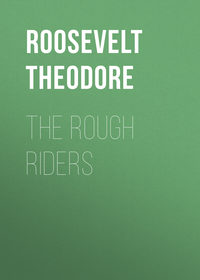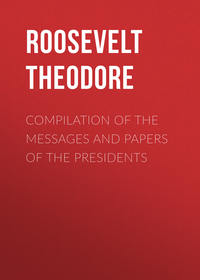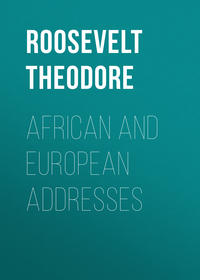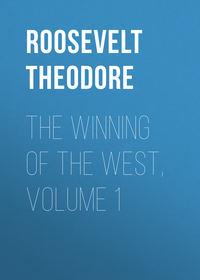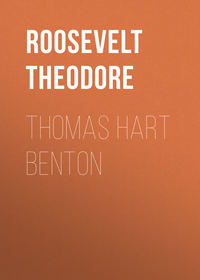 полная версия
полная версияThrough the Brazilian Wilderness
Twenty-one years later, in April, 1898, he was camped on the same lake, but on the north shore, at the foot of a basaltic cliff. He was in company with four soldiers, with whom he had travelled from the Strait of Magellan. In the night he was aroused by the shriek of a man and the barking of his dogs. As the men sprang up from where they were lying asleep they saw a large puma run off out of the firelight into the darkness. It had sprung on a soldier named Marcelino Huquen while he was asleep, and had tried to carry him off. Fortunately, the man was so wrapped up in his blanket, as the night was cold, that he was not injured. The puma was never found or killed.
About the same time a surveyor of Doctor Moreno's party, a Swede named Arneberg, was attacked in similar fashion. The doctor was not with him at the time. Mr. Arneberg was asleep in the forest near Lake San Martin. The cougar both bit and clawed him, and tore his mouth, breaking out three teeth. The man was rescued; but this puma also escaped.
The doctor stated that in this particular locality the Indians, who elsewhere paid no heed whatever to the puma, never let their women go out after wood for fuel unless two or three were together. This was because on several occasions women who had gone out alone were killed by pumas. Evidently in this one locality the habit of at least occasional man-eating has become chronic with a species which elsewhere is the most cowardly, and to man the least dangerous, of all the big cats.
These observations of Doctor Moreno have a peculiar value, because, as far as I know, they are the first trustworthy accounts of a cougar's having attacked man save under circumstances so exceptional as to make the attack signify little more than the similar exceptional instances of attack by various other species of wild animals that are not normally dangerous to man.
The jaguar, however, has long been known not only to be a dangerous foe when itself attacked, but also now and then to become a man-eater. Therefore the instances of such attacks furnished me are of merely corroborative value.
In the excellent zoological gardens at Buenos Aires the curator, Doctor Onelli, a naturalist of note, showed us a big male jaguar which had been trapped in the Chaco, where it had already begun a career as a man-eater, having killed three persons. They were killed, and two of them were eaten; the animal was trapped, in consequence of the alarm excited by the death of his third victim. This jaguar was very savage; whereas a young jaguar, which was in a cage with a young tiger, was playful and friendly, as was also the case with the young tiger. On my trip to visit La Plata Museum I was accompanied by Captain Vicente Montes, of the Argentine Navy, an accomplished officer of scientific attainments. He had at one time been engaged on a survey of the boundary between the Argentine and Parana and Brazil. They had a quantity of dried beef in camp. On several occasions a jaguar came into camp after this dried beef. Finally they succeeded in protecting it so that he could not reach it. The result, however, was disastrous. On the next occasion that he visited camp, at midnight, he seized a man. Everybody was asleep at the time, and the jaguar came in so noiselessly as to elude the vigilance of the dogs. As he seized the man, the latter gave one yell, but the next moment was killed, the jaguar driving his fangs through the man's skull into the brain. There was a scene of uproar and confusion, and the jaguar was forced to drop his prey and flee into the woods. Next morning they followed him with the dogs, and finally killed him. He was a large male, in first-class condition. The only features of note about these two incidents was that in each case the man-eater was a powerful animal in the prime of life; whereas it frequently happens that the jaguars that turn man- eaters are old animals, and have become too inactive or too feeble to catch their ordinary prey.
During the two months before starting from Asuncion, in Paraguay, for our journey into the interior, I was kept so busy that I had scant time to think of natural history. But in a strange land a man who cares for wild birds and wild beasts always sees and hears something that is new to him and interests him. In the dense tropical woods near Rio Janeiro I heard in late October—springtime, near the southern tropic—the songs of many birds that I could not identify. But the most beautiful music was from a shy woodland thrush, sombre-colored, which lived near the ground in the thick timber, but sang high among the branches. At a great distance we could hear the ringing, musical, bell-like note, long-drawn and of piercing sweetness, which occurs at intervals in the song; at first I thought this was the song, but when it was possible to approach the singer I found that these far-sounding notes were scattered through a continuous song of great melody. I never listened to one that impressed me more. In different places in Argentina I heard and saw the Argentine mocking-bird, which is not very unlike our own, and is also a delightful and remarkable singer. But I never heard the wonderful white-banded mocking-bird, which is said by Hudson, who knew well the birds of both South America and Europe, to be the song-king of them all.
Most of the birds I thus noticed while hurriedly passing through the country were, of course, the conspicuous ones. The spurred lapwings, big, tame, boldly marked plover, were everywhere; they were very noisy and active and both inquisitive and daring, and they have a very curious dance custom. No man need look for them. They will look for him, and when they find him they will fairly yell the discovery to the universe. In the marshes of the lower Parana I saw flocks of scarlet- headed blackbirds on the tops of the reeds; the females are as strikingly colored as the males, and their jet-black bodies and brilliant red heads make it impossible for them to escape observation among their natural surroundings. On the plains to the west I saw flocks of the beautiful rose-breasted starlings; unlike the red-headed blackbirds, which seemed fairly to court attention, these starlings sought to escape observation by crouching on the ground so that their red breasts were hidden. There were yellow-shouldered blackbirds in wet places, and cow-buntings abounded.
But the most conspicuous birds I saw were members of the family of tyrant flycatchers, of which our own king-bird is the most familiar example. This family is very numerously represented in Argentina, both in species and individuals. Some of the species are so striking, both in color and habits, and in one case also in shape, as to attract the attention of even the unobservant. The least conspicuous, and nevertheless very conspicuous, among those that I saw was the bientevido, which is brown above, yellow beneath, with a boldly marked black and white head, and a yellow crest. It is very noisy, is common in the neighborhood of houses, and builds a big domed nest. It is really a big, heavy kingbird, fiercer and more powerful than any northern kingbird. I saw them assail not only the big but the small hawks with fearlessness, driving them in headlong flight. They not only capture insects, but pounce on mice, small frogs, lizards, and little snakes, rob birds' nests of the fledgling young, and catch tadpoles and even small fish.
Two of the tyrants which I observed are like two with which I grew fairly familiar in Texas. The scissor-tail is common throughout the open country, and the long tail feathers, which seem at times to hamper its flight, attract attention whether the bird is in flight or perched on a tree. It has a habit of occasionally soaring into the air and descending in loops and spirals. The scarlet tyrant I saw in the orchards and gardens. The male is a fascinating little bird, coal- black above, while his crested head and the body beneath are brilliant scarlet. He utters his rapid, low-voiced musical trill in the air, rising with fluttering wings to a height of a hundred feet, hovering while he sings, and then falling back to earth. The color of the bird and the character of his performance attract the attention of every observer, bird, beast, or man, within reach of vision.
The red-backed tyrant is utterly unlike any of his kind in the United States, and until I looked him up in Sclater and Hudson's ornithology I never dreamed that he belonged to this family. He—for only the male is so brightly colored—is coal-black with a dull-red back. I saw these birds on December 1 near Barilloche, out on the bare Patagonian plains. They behaved like pipits or longspurs, running actively over the ground in the same manner and showing the same restlessness and the same kind of flight. But whereas pipits are inconspicuous, the red-backs at once attracted attention by the contrast between their bold coloring and the grayish or yellowish tones of the ground along which they ran. The silver-bill tyrant, however, is much more conspicuous; I saw it in the same neighborhood as the red-back and also in many other places. The male is jet-black, with white bill and wings. He runs about on the ground like a pipit, but also frequently perches on some bush to go through a strange flight-song performance. He perches motionless, bolt upright, and even then his black coloring advertises him for a quarter of a mile round about. But every few minutes he springs up into the air to the height of twenty or thirty feet, the white wings flashing in contrast to the black body, screams and gyrates, and then instantly returns to his former post and resumes his erect pose of waiting. It is hard to imagine a more conspicuous bird than the silver-bill; but the next and last tyrant flycatcher of which I shall speak possesses on the whole the most advertising coloration of any small bird I have ever seen in the open country, and moreover this advertising coloration exists in both sexes and throughout the year. It is a brilliant white, all over, except the long wing-quills and the ends of the tail-feathers, which are black. The first one I saw, at a very long distance, I thought must be an albino. It perches on the top of a bush or tree watching for its prey, and it shines in the sun like a silver mirror. Every hawk, cat, or man must see it; no one can help seeing it.
These common Argentine birds, most of them of the open country, and all of them with a strikingly advertising coloration, are interesting because of their beauty and their habits. They are also interesting because they offer such illuminating examples of the truth that many of the most common and successful birds not merely lack a concealing coloration, but possess a coloration which is in the highest degree revealing. The coloration and the habits of most of these birds are such that every hawk or other foe that can see at all must have its attention attracted to them. Evidently in their cases neither the coloration nor any habit of concealment based on the coloration is a survival factor, and this although they live in a land teeming with bird-eating hawks. Among the higher vertebrates there are many known factors which have influence, some in one set of cases, some in another set of cases, in the development and preservation of species. Courage, intelligence, adaptability, prowess, bodily vigor, speed, alertness, ability to hide, ability to build structures which will protect the young while they are helpless, fecundity—all, and many more like them, have their several places; and behind all these visible causes there are at work other and often more potent causes of which as yet science can say nothing. Some species owe much to a given attribute which may be wholly lacking in influence on other species; and every one of the attributes above enumerated is a survival factor in some species, while in others it has no survival value whatever, and in yet others, although of benefit, it is not of sufficient benefit to offset the benefit conferred on foes or rivals by totally different attributes. Intelligence, for instance, is of course a survival factor; but to-day there exist multitudes of animals with very little intelligence which have persisted through immense periods of geologic time either unchanged or else without any change in the direction of increased intelligence; and during their species-life they have witnessed the death of countless other species of far greater intelligence but in other ways less adapted to succeed in the environmental complex. The same statement can be made of all the many, many other known factors in development, from fecundity to concealing coloration; and behind them lie forces as to which we veil our ignorance by the use of high-sounding nomenclature—as when we use such a convenient but far from satisfactory term as orthogenesis.
II. UP THE PARAGUAY
On the afternoon of December 9 we left the attractive and picturesque city of Asuncion to ascend the Paraguay. With generous courtesy the Paraguayan Government had put at my disposal the gunboat-yacht of the President himself, a most comfortable river steamer, and so the opening days of our trip were pleasant in every way. The food was good, our quarters were clean, we slept well, below or on deck, usually without our mosquito-nettings, and in daytime the deck was pleasant under the awnings. It was hot, of course, but we were dressed suitably in our exploring and hunting clothes and did not mind the heat. The river was low, for there had been dry weather for some weeks —judging from the vague and contradictory information I received there is much elasticity to the terms wet season and dry season at this part of the Paraguay. Under the brilliant sky we steamed steadily up the mighty river; the sunset was glorious as we leaned on the port railing; and after nightfall the moon, nearly full and hanging high in the heavens, turned the water to shimmering radiance. On the mud-flats and sandbars, and among the green rushes of the bays and inlets, were stately water-fowl; crimson flamingoes and rosy spoonbills, dark- colored ibis and white storks with black wings. Darters, with snakelike necks and pointed bills, perched in the trees on the brink of the river. Snowy egrets flapped across the marshes. Caymans were common, and differed from the crocodiles we had seen in Africa in two points: they were not alarmed by the report of a rifle when fired at, and they lay with the head raised instead of stretched along the sand.
For three days, as we steamed northward toward the Tropic of Capricorn, and then passed it, we were within the Republic of Paraguay. On our right, to the east, there was a fairly well-settled country, where bananas and oranges were cultivated and other crops of hot countries raised. On the banks we passed an occasional small town, or saw a ranch-house close to the river's brink, or stopped for wood at some little settlement. Across the river to the west lay the level, swampy, fertile wastes known as the Chaco, still given over either to the wild Indians or to cattle-ranching on a gigantic scale. The broad river ran in curves between mud-banks where terraces marked successive periods of flood. A belt of forest stood on each bank, but it was only a couple of hundred yards wide. Back of it was the open country; on the Chaco side this was a vast plain of grass, dotted with tall, graceful palms. In places the belt of forest vanished and the palm- dotted prairie came to the river's edge. The Chaco is an ideal cattle country, and not really unhealthy. It will be covered with ranches at a not distant day. But mosquitoes and many other winged insect pests swarm over it. Cherrie and Miller had spent a week there collecting mammals and birds prior to my arrival at Asuncion. They were veterans of the tropics, hardened to the insect plagues of Guiana and the Orinoco. But they reported that never had they been so tortured as in the Chaco. The sand-flies crawled through the meshes in the mosquito- nets, and forbade them to sleep; if in their sleep a knee touched the net the mosquitoes fell on it so that it looked as if riddled by birdshot; and the nights were a torment, although they had done well in their work, collecting some two hundred and fifty specimens of birds and mammals.
Nevertheless for some as yet inscrutable reason the river served as a barrier to certain insects which are menaces to the cattlemen. With me on the gunboat was an old Western friend, Tex Rickard, of the Panhandle and Alaska and various places in between. He now has a large tract of land and some thirty-five thousand head of cattle in the Chaco, opposite Concepcion, at which city he was to stop. He told me that horses did not do well in the Chaco but that cattle throve, and that while ticks swarmed on the east bank of the great river, they would not live on the west bank. Again and again he had crossed herds of cattle which were covered with the loathsome bloodsuckers; and in a couple of months every tick would be dead. The worst animal foes of man, indeed the only dangerous foes, are insects; and this is especially true in the tropics. Fortunately, exactly as certain differences too minute for us as yet to explain render some insects deadly to man or domestic animals, while closely allied forms are harmless, so, for other reasons, which also we are not as yet able to fathom, these insects are for the most part strictly limited by geographical and other considerations. The war against what Sir Harry Johnston calls the really material devil, the devil of evil wild nature in the tropics, has been waged with marked success only during the last two decades. The men, in the United States, in England, France, Germany, Italy—the men like Doctor Cruz in Rio Janeiro and Doctor Vital Brazil in Sao Paulo—who work experimentally within and without the laboratory in their warfare against the disease and death bearing insects and microbes, are the true leaders in the fight to make the tropics the home of civilized man.
Late on the evening of the second day of our trip, just before midnight, we reached Concepcion. On this day, when we stopped for wood or to get provisions—at picturesque places, where the women from rough mud and thatched cabins were washing clothes in the river, or where ragged horsemen stood gazing at us from the bank, or where dark, well-dressed ranchmen stood in front of red-roofed houses—we caught many fish. They belonged to one of the most formidable genera of fish in the world, the piranha or cannibal fish, the fish that eats men when it can get the chance. Farther north there are species of small piranha that go in schools. At this point on the Paraguay the piranha do not seem to go in regular schools, but they swarm in all the waters and attain a length of eighteen inches or over. They are the most ferocious fish in the world. Even the most formidable fish, the sharks or the barracudas, usually attack things smaller than themselves. But the piranhas habitually attack things much larger than themselves. They will snap a finger off a hand incautiously trailed in the water; they mutilate swimmers—in every river town in Paraguay there are men who have been thus mutilated; they will rend and devour alive any wounded man or beast; for blood in the water excites them to madness. They will tear wounded wild fowl to pieces; and bite off the tails of big fish as they grow exhausted when fighting after being hooked. Miller, before I reached Asuncion, had been badly bitten by one. Those that we caught sometimes bit through the hooks, or the double strands of copper wire that served as leaders, and got away. Those that we hauled on deck lived for many minutes. Most predatory fish are long and slim, like the alligator-gar and pickerel. But the piranha is a short, deep-bodied fish, with a blunt face and a heavily undershot or projecting lower jaw which gapes widely. The razor-edged teeth are wedge-shaped like a shark's, and the jaw muscles possess great power. The rabid, furious snaps drive the teeth through flesh and bone. The head with its short muzzle, staring malignant eyes, and gaping, cruelly armed jaws, is the embodiment of evil ferocity; and the actions of the fish exactly match its looks. I never witnessed an exhibition of such impotent, savage fury as was shown by the piranhas as they flapped on deck. When fresh from the water and thrown on the boards they uttered an extraordinary squealing sound. As they flapped about they bit with vicious eagerness at whatever presented itself. One of them flapped into a cloth and seized it with a bulldog grip. Another grasped one of its fellows; another snapped at a piece of wood, and left the teeth-marks deep therein. They are the pests of the waters, and it is necessary to be exceedingly cautious about either swimming or wading where they are found. If cattle are driven into, or of their own accord enter, the water, they are commonly not molested; but if by chance some unusually big or ferocious specimen of these fearsome fishes does bite an animal—taking off part of an ear, or perhaps of a teat from the udder of a cow—the blood brings up every member of the ravenous throng which is anywhere near, and unless the attacked animal can immediately make its escape from the water it is devoured alive. Here on the Paraguay the natives hold them in much respect, whereas the caymans are not feared at all. The only redeeming feature about them is that they are themselves fairly good to eat, although with too many bones.
At daybreak of the third day, finding we were still moored off Concepcion, we were rowed ashore and strolled off through the streets of the quaint, picturesque old town; a town which, like Asuncion, was founded by the conquistadores three-quarters of a century before our own English and Dutch forefathers landed in what is now the United States. The Jesuits then took practically complete possession of what is now Paraguay, controlling and Christianizing the Indians, and raising their flourishing missions to a pitch of prosperity they never elsewhere achieved. They were expelled by the civil authorities (backed by the other representatives of ecclesiastical authority) some fifty years before Spanish South America became independent. But they had already made the language of the Indians, Guarany, a culture- tongue, reducing it to writing, and printing religious books in it. Guarany is one of the most wide-spread of the Indian tongues, being originally found in various closely allied forms not only in Paraguay but in Uruguay and over the major part of Brazil. It remains here and there, as a lingua general at least, and doubtless in cases as an original tongue, among the wild tribes. In most of Brazil, as around Para and around Sao Paulo, it has left its traces in place-names, but has been completely superseded as a language by Portuguese. In Paraguay it still exists side by side with Spanish as the common language of the lower people and as a familiar tongue among the upper classes. The blood of the people is mixed, their language dual; the lower classes are chiefly of Indian blood but with a white admixture; while the upper classes are predominantly white, with a strong infusion of Indian. There is no other case quite parallel to this in the annals of European colonization, although the Goanese in India have a native tongue and a Portuguese creed, while in several of the Spanish-American states the Indian blood is dominant and the majority of the population speak an Indian tongue, perhaps itself, as with the Quichuas, once a culture-tongue of the archaic type. Whether in Paraguay one tongue will ultimately drive out the other, and, if so, which will be the victor, it is yet too early to prophesy. The English missionaries and the Bible Society have recently published parts of the Scriptures in Guarany and in Asuncion a daily paper is published with the text in parallel columns, Spanish and Guarany—just as in Oklahoma there is a similar paper published in English and in the tongue which the extraordinary Cherokee chief Sequoia, a veritable Cadmus, made a literary language.
The Guarany-speaking Paraguayan is a Christian, and as much an inheritor of our common culture as most of the peasant populations of Europe. He has no kinship with the wild Indian, who hates and fears him. The Indian of the Chaco, a pure savage, a bow-bearing savage, will never come east of the Paraguay, and the Paraguayan is only beginning to venture into the western interior, away from the banks of the river—under the lead of pioneer settlers like Rickard, whom, by the way, the wild Indians thoroughly trust, and for whom they work eagerly and faithfully. There is a great development ahead for Paraguay, as soon as they can definitely shake off the revolutionary habit and establish an orderly permanence of government. The people are a fine people; the strains of blood—white and Indian—are good.




